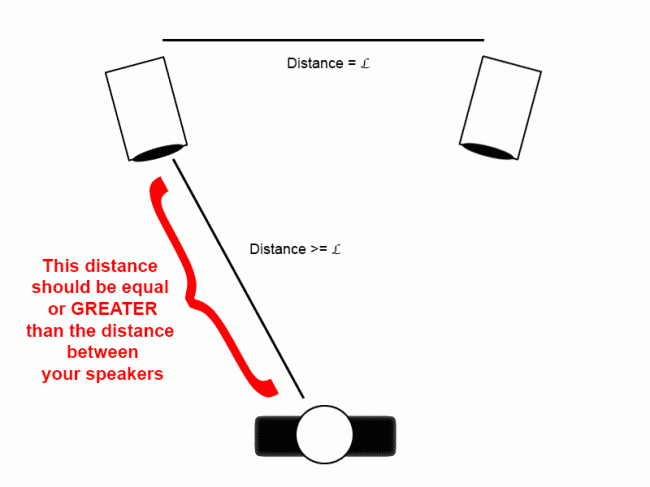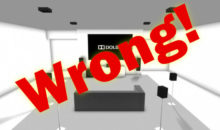Speaker Placement Guidelines and Tips
Every now and then I like to remind our readers that sometimes, just sometimes, you can improve your home theater simply by taking a fresh look at your room and adjusting your speaker placement. In particular, there are ways in which a good pair of speakers can become a great pair of speakers just by taking the time to place them properly in the room. These speaker placement guidelines can give you a renewed sense of realism and detail that may have been “hidden” in your room.
Stay Away from Corners
Whenever possible, you want to move your speaker(s) out of a corner. The problem with corners is that, typically, you only have one speaker that’s placed there. This results in about a 3x boost in low frequency response—but only from the one speaker. It throws the balance off quite a bit, and you’ll often end up balancing your system (setting your left/right levels) differently as a result. This means that, while your overall speaker levels might be matched, you’re actually favoring the non-corner-loaded speaker, whose lack of bass caused you to raise its output volume. If you must corner-load a speaker, be aware of this pitfall, and ensure you get a nice, even soundstage. You can also attempt, as best as possible, to bring your speaker out of the corner by as much as 2-3 feet, or whatever you can spare. The further out of the corner it is, the less the affects of boundary gain (low-frequency boost from the side and rear walls) will affect its output.
Get Your Tweeters at Ear Level
When you place bookshelf speakers on stands, be sure to get the correct height stands. I’ve seen so many instances where tweeters are firing at a much higher level than your ears. A shorter stand would solve this (and they do come in various sizes if you look hard enough). The problem with not lining up your tweeters is that you then fire them off-axis when they were measured and designed to be fired when placed properly (at ear level). One more tip is to ensure that your rear-ported speakers aren’t placed on a bookshelf or against a wall. Give those ports room to breathe and you’ll experience a much more even frequency response across the soundstage (the ability for the left and right speakers to create a lifelike representation of the audio experience).
Get Away from the Wall!
Like stand-mounted bookshelf speakers, floor standing speakers, or tower speakers, should also be moved two feet away from any boundary or wall. Doing this will ensure that your speaker is working as it was designed and not emphasizing bass frequencies from being found in proximity to a wall. When you place a speaker too close to a wall (and it doesn’t have any built-in way to compensate for this), you’re essentially using an “EQ” to raise the lower frequencies—but in a way that isn’t linear and predictable. Move your speakers out whenever possible and you’ll experience a much better, more accurate, sound.
The Golden Triangle
You don’t want to be too close or too far away from your speakers when you’re listening to them. Ideally, the distance between the speakers will be similar to the distance you are from them. They can be slightly closer together, but you should avoid, whenever possible, having your speakers be further apart than the distance from you to either speaker (measured from the center listening position). If you’re too close, those speakers cannot image properly, and that means your soundstage will not be accurate and the stereo effects of the speakers will be much less accurate.

Center Your Listening Area
Sometimes when I walk into a friend’s listening room I notice that the listening position isn’t nearly centered to the speakers. While not every seat can be located in the middle, it’s nice to arrange your room so that when you really want to enjoy a piece of music you can locate yourself where the stereo image will be more accurate and enveloping. A good pair of speakers won’t collapse the second you duck out of the exact center, but you’ll find that your music is far more enjoyable if you create a nice centralized seat.
Calibrate That Subwoofer!
The subwoofer, in addition to being one of the most valuable and enjoyable speakers in a home theater or listening room, can also do the most to destroy the cohesiveness and purity of your music or soundtracks. For one, bass can disrupt any number of frequencies in a music or movie mix. Use our tips on subwoofer placement to ensure that you position your sub in the best possible location for smooth bass response and a full-range sound that isn’t thrown off by out-of-control dips and peaks.
Hopefully, these speaker placement guidelines and tips have helped you come up with some ideas to improve your home theater or listening room without spending a dime this year. If you can take what you have and make it better, then you’ve definitely done something worthwhile to improve your AV system.








It’s easy if everyone has a dedicated room to do what Clint says. However many, me included, have to share our hobby with our family in a common living room. Sometimes even the size itself post a problem. However, well written and easy to follow. Thanks.